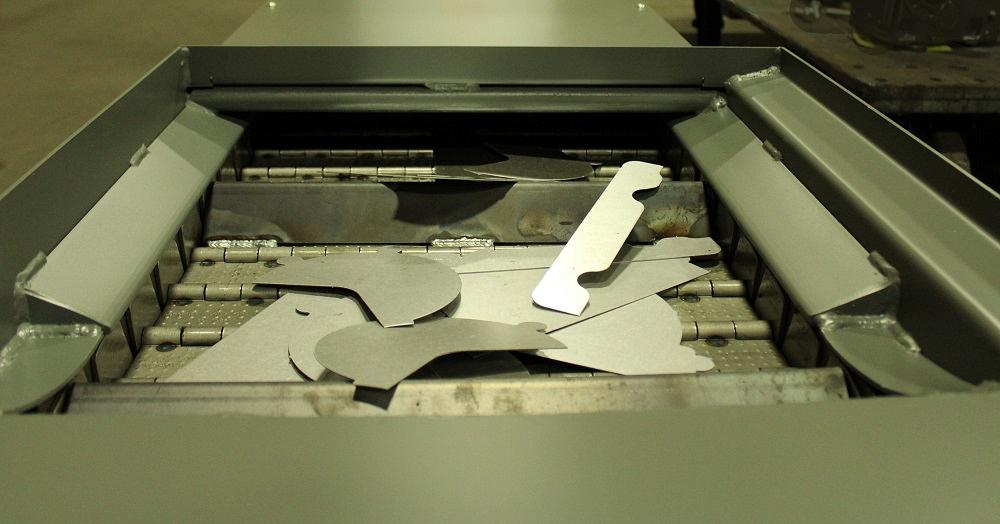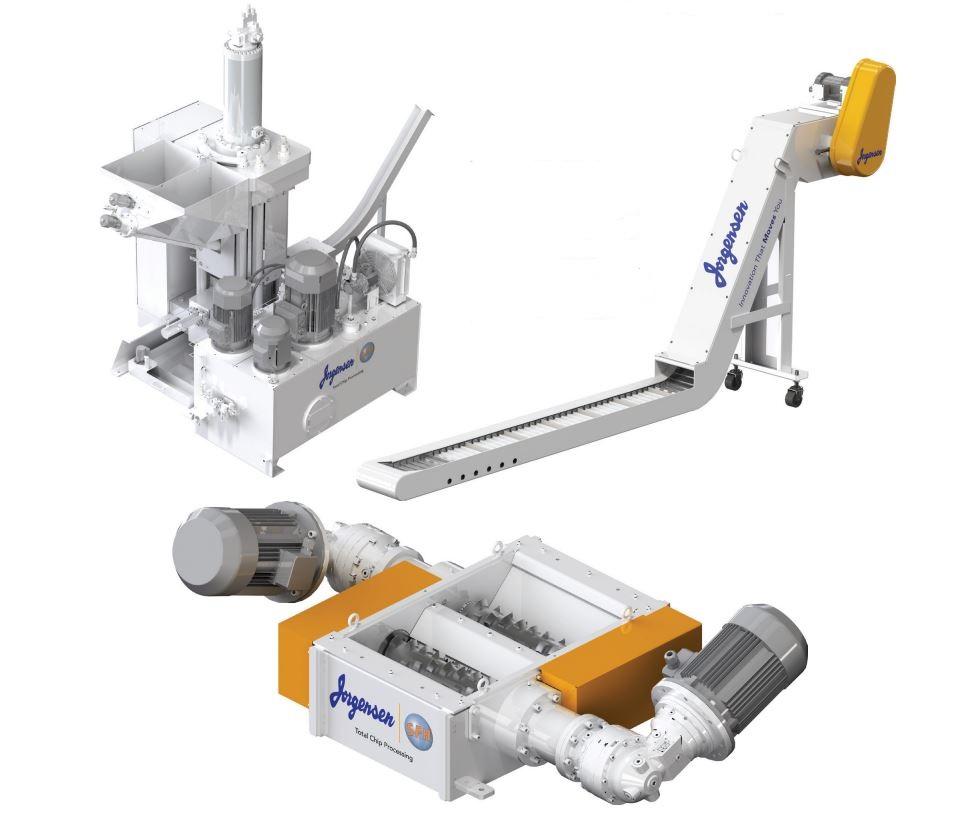Marketing Communications Manager
- FMA
- The Fabricator
- FABTECH
- Canadian Metalworking
Categories
- Additive Manufacturing
- Aluminum Welding
- Arc Welding
- Assembly and Joining
- Automation and Robotics
- Bending and Forming
- Consumables
- Cutting and Weld Prep
- Electric Vehicles
- En Español
- Finishing
- Hydroforming
- Laser Cutting
- Laser Welding
- Machining
- Manufacturing Software
- Materials Handling
- Metals/Materials
- Oxyfuel Cutting
- Plasma Cutting
- Power Tools
- Punching and Other Holemaking
- Roll Forming
- Safety
- Sawing
- Shearing
- Shop Management
- Testing and Measuring
- Tube and Pipe Fabrication
- Tube and Pipe Production
- Waterjet Cutting
Industry Directory
Webcasts
Podcasts
FAB 40
Advertise
Subscribe
Account Login
Search
Conveyors, complete scrap processing systems help automate stamping
Systems go a long way toward meeting labor shortage, productivity needs
- By Colin Reak
- November 17, 2022
- Article
- Materials Handling

A conveyor system or complete scrap processing system can go a long way toward reducing physical labor requirements and automating many of the strenuous tasks undertaken in today’s stamping shops.
The stamping industry has seen many changes in recent years, with an emphasis on maximizing productivity. Several trends are directing stampers’ decisions regarding material handling conveyors and scrap management systems.
Industry Trends
Operators are now responsible for more machines than ever before. A focus on productivity, paired with a shortage of physical labor in today’s marketplace, has many shops looking toward automation to reduce the physical labor required to produce finished goods continuously. A conveyor system or complete scrap processing system can go a long way toward reducing physical labor requirements and automating many of the strenuous tasks undertaken in today’s stamping shops.
Many shops also are transitioning to running 24-hour operations. If you transition to non-stop operations, it is more important than ever to have a scrap handling strategy that reduces shutdowns and increases productivity. Conveyors and scrap processing equipment can automate scrap removal, reduce touch points, decrease total scrap volume, and increase scrap value.
5 Considerations for Conveyor Implementation
There are a few key items to keep in mind when installing a conveyor system for stamping applications:
- Assess the space available around the machine. It is vital to get accurate measurements of the area where the conveyor will be placed. Also, the space available may influence which features can be designed into the conveyor or may limit the load volume it is able to handle.
- Look at the size of the parts and material that will be transported. Small stampings may require additional conveyor features to keep the stampings from migrating or pinching within the belting, while large stampings may require application-specific inclines and cleat spacing.
- Identify the discharge height needed to execute the shop’s overall scrap handling strategy. There may be a specific discharge height required for dumping into a collection bin at the machine, a central hopper, or a scrap processing system.
- Determine the overall scrap handling strategy is based on a machine-by-machine strategy or if a central system that will handle many machines is preferred.
- Decide if scrap processing (shredding, wringing, or briquetting) will be part of the shop’s overall scrap handling strategy. Usually, scrap processing equipment is used in stamping applications when the scrap material’s sheet thickness does not exceed 4 to 10 mm thick, depending on the material. Scrap processing equipment may also be used to reclaim oil or coolant. Scrap processing should be considered early on in the conveyor system implementation, as it may affect the required discharge height or other design aspects of the system.
Training, Maintenance, Safety
Conveyor equipment automates strenuous tasks but requires proper training, maintenance, and safety standards to maintain worry-free operation. One of the most important items to keep in mind when working with a conveyor system is to avoid pinch points, moving belting, and components. Guards should be removed only to complete maintenance. They should always be reattached after maintenance is complete and before resuming conveyor operation.
It is also important to keep hands and feet away from moving conveyor parts. Do not stand, play, or ride on conveyor belting. Each pitch of belt is a possible pinch point that may cause severe damage to humans and machinery. Additional design features may be added to reduce the chances of injury, such as cover plates and guards, but proper safety training is important.
Maintenance also is a vital part of an effective scrap management system. Moving equipment should always be locked and tagged out when maintenance is being conducted. All employees operating these machines should be trained on proper belt tension, variable drive fault codes, and the proper jam removal process. With the proper training and safety procedures, the addition of a conveyor or scrap processing system can have massive impacts on overall shop efficiency by eliminating downtime, reducing physical labor, and increasing employee safety.
Tips for More Efficient Operation
Here are a few tips and general guidelines to help you make sure your scrap handling or conveyor system runs smoothly and efficiently:
- First, make sure your conveyor system is designed—or approved—to handle your application. If the conveyor is not designed to the specific part size, material thickness, and application, complications may arise, or the longevity of the conveyor may suffer.
- Incorporate cleanout features into the system’s design. These cleanouts can reduce the maintenance time needed to keep the system running smoothly.
- Make sure the belt is properly tensioned. The conveyor will run more accurately and efficiently with a properly tensioned belt, reducing the chance of jams and eliminating premature wear.
All of these tips and products by themselves can represent productivity gains. However, to maximize efficiency, reduce touch points, and further increase safety, a complete scrap handling system is recommended. Scrap processing equipment can decrease scrap volume and increase scrap value, potentially.
A stamping shop can reduce its overall scrap volume with a shredder. This volume reduction can, in turn, cut down on the number of times a bin needs to be emptied in a day. It also can allow a shop to fit more scrap into each truck load.

The combination of conveyors, shredders, and briquetters can almost completely automate the scrap removal process, allowing shops and operators to run 24 hours a day with limited interruption. At left, a hinge steel conveyor; center, a shredder; at right, a briquetter.
A briquetter system can also be a useful addition to a shop’s scrap handling strategy. These machines compress scrap into tight briquettes. Not only does this decrease scrap volume, briquettes are often preferred by recyclers, increasing the value of the scrap and generating additional unrecognized profit. In addition, briquettes are more easily stored than unprocessed or shredded scrap.
The combination of conveyors, shredders, and briquetters can almost completely automate the scrap removal process, allowing shops and operators to run 24 hours a day with limited interruption. Limiting downtime and physical labor required to produce products increases profitability, lowers injury risk, and allows employees to focus on other profit generating tasks.
About the Author
Colin Reak
10303 North Baehr Rd.
Mequon, WI 53092
(262)-242-3089
Related Companies
subscribe now

The Fabricator is North America's leading magazine for the metal forming and fabricating industry. The magazine delivers the news, technical articles, and case histories that enable fabricators to do their jobs more efficiently. The Fabricator has served the industry since 1970.
start your free subscription- Stay connected from anywhere

Easily access valuable industry resources now with full access to the digital edition of The Fabricator.

Easily access valuable industry resources now with full access to the digital edition of The Welder.

Easily access valuable industry resources now with full access to the digital edition of The Tube and Pipe Journal.
- Podcasting
- Podcast:
- The Fabricator Podcast
- Published:
- 04/16/2024
- Running Time:
- 63:29
In this episode of The Fabricator Podcast, Caleb Chamberlain, co-founder and CEO of OSH Cut, discusses his company’s...
- Trending Articles
Capturing, recording equipment inspection data for FMEA

Tips for creating sheet metal tubes with perforations

Are two heads better than one in fiber laser cutting?

Supporting the metal fabricating industry through FMA

Omco Solar opens second Alabama manufacturing facility

- Industry Events
16th Annual Safety Conference
- April 30 - May 1, 2024
- Elgin,
Pipe and Tube Conference
- May 21 - 22, 2024
- Omaha, NE
World-Class Roll Forming Workshop
- June 5 - 6, 2024
- Louisville, KY
Advanced Laser Application Workshop
- June 25 - 27, 2024
- Novi, MI


























